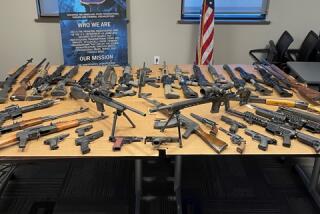Family of slain agent ‘sickened’ feds didn’t share information
Family members of slain U.S. Border Patrol Agent Brian Terry said they were “sickened” by reports that federal law enforcement agencies on the Southwest border did not share information about their investigations, and believe Terry would be alive today had the ATF known that two top targets in their Fast and Furious case actually were FBIinformants.
“It is beyond our comprehension that U.S. federal law enforcement agencies were not talking with one another,” the family said in a statement released Wednesday by their Phoenix attorney, Lincoln Combs. “American citizens deserve better from their public servants.”
Combs added that the FBI, theBureau of Alcohol, Tobacco, Firearms and Explosives, and other federal agencies “should have been coordinating their investigative and prosecutorial efforts. This coordination should have started and continued with basic information sharing” to sort out leads gathered by the various agencies.
At the FBI, officials declined to comment, noting that they are continuing to investigate the Terry murder. ATF officials also declined to comment, though spokesman Drew Wade has acknowledged that Fast and Furious “was a mistake.”
Under the ATF’s failed Fast and Furious gun-tracking operation in Arizona, agents allowed illegal gun purchases in the hope of snaring Mexican drug cartel leaders. What they apparently did not know was that two of the cartel leaders they were pursuing were brothers working as FBI informants, and had been given immunity from prosecution.
Furthermore, the alleged top gun smuggler in Fast and Furious, identified as Manuel Celis-Acosta, was stopped three times but released by agents. Had he been arrested, Fast and Furious might have come to an early close, before Terry was killed in a December 2010 shootout at the border. Two weapons the government lost track of in Fast and Furious were discovered at the scene.
ATF records show that Celis-Acosta was stopped Dec. 9, 2009, in Phoenix, after he and an alleged conspirator were pulled over in a pickup with firearms they had purchased illegally. Agents assigned to the Fast and Furious operation had monitored the illegal purchases, trailed Celis-Acosta and then questioned him, finally letting him go.
The second stop was March 26, 2010, in Phoenix, when he was released after being stopped with a Colt .38-caliber pistol he’d also bought under surveillance. The third time was on May 29, 2010, when he was pulled over at Lukeville, Ariz., near the U.S-Mexico border with 74 rounds of live ammunition, and again set free.
Authorities have yet to explain publicly why Celis-Acosta was repeatedly released.
ALSO:
Texas jury convicts Warren Jeffs follower of bigamy
Jet Blue pilot suspended, charged after mid-air meltdowns
Alicia Silverstone’s baby-feeding habits dangerous, experts say
richard.serrano@latimes.com
More to Read
Start your day right
Sign up for Essential California for news, features and recommendations from the L.A. Times and beyond in your inbox six days a week.
You may occasionally receive promotional content from the Los Angeles Times.







